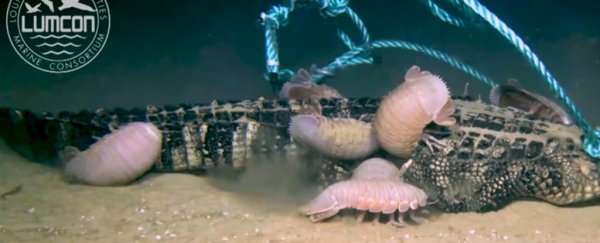Sixty-five million years ago, planet Earth was pummelled by a wave of extinction that left few marine organisms alive.
Now scientists are trying to coax what's left out of the abyss and into the limelight, baiting ancient residents with a rare delicacy of the past.
A gross, yet fascinating new video shows a troop of deep-sea bugs chowing down on the carcass of an alligator, which researchers from Louisiana Universities Marine Consortium (LUMCON) dropped two kilometres (1.2 miles) deep in the Gulf of Mexico.
Within 24 hours, the giant invertebrates had somehow sniffed out the rare meal, gorging themselves to the point where they basically became "immobile" or "stupefied", at times nosediving into the ground.
"I was surprised there were already giant isopods all over it," Craig McCLain from the LUMCON team explains in the video.
"I thought it would take a while for them to get the chemical cues that would allow them to sort of locate a food fall like an alligator."
It sounds absurd, and it looks, if possible, even more so. The pink football-sized roaches are called giant isopods (Bathynomus giganteus), and some groups are thought to have an ancient origin in the deep sea, going back 200 or 300 million years.
As the researchers explain in their video, these eerie creatures are actually related to pill bugs, except they're massive. They're amongst the strangest creatures found in the deep sea, and endurance is kinda their thing - they can go without food for months, sometimes even years.
Buried deep under the ocean's surface, leagues from a light source, they must forage for carbon wherever they can get it. This means that when a whale or large fish dies and sinks, its body becomes a food oasis in an otherwise deserted landscape.
Alligators, the researchers say, may be the last refuge for some of the more ancient invertebrates.
"Before the existence of whales," writes McClain, "perhaps large marine reptiles like ichthyosaurs, mosasaurs, and plesiosaurs hosted diverse and endemic invertebrate communities on sunken carcasses."
There's plenty of fossil research to suggest this might have been the case. In fact, it probably still is.
Major rivers, tropical storms and even hurricanes have all played a hand in carrying alligators out into the Gulf, sometimes as far as 25 kilometres (15 miles) offshore, as was the case during Hurricane Katrina.
Thanks to what is notably the first recorded 'reptile fall', we now know that if these creatures do sink, their carcasses will not go to waste. And it's unlikely the isopods will be the only scavengers making a visit.
Once the pill bugs have slashed through the carcass and are eating it from within, smaller organisms might come along and try their chances with the scraps.
The researchers predict that half the carcass will be gone in two months, when they will return to the site.
Now we just wait.
